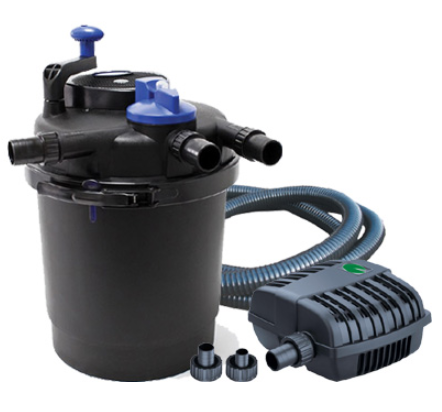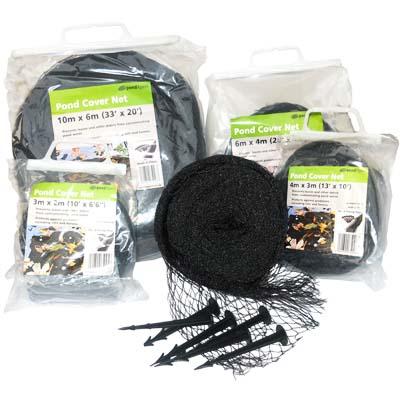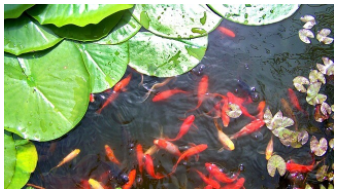5 Tips Which Can Make A Big Difference To Your Pond
Below, we have listed five different ways in which your pond maintenance can be reduced. These are all preventative measures; designed to encourage suitable filtration levels, aerations and removing debris before it forms sludge at the bottom of your pond. Preventing debris from decaying helps to manage the chemicals in your water and helps you maintain a good ecosystem; keeping water clear, clean and keeping your fish happy.

Purchase a suitable Pump and Filter system (Useful Blogs: Filters & Their Maintenance, Filtration: The Stages of Filtration, Benefits of UV Filtration in your Pond)
Making sure you get a suitable pump and filter system for your pond is one of the most important jobs any Pondkeeper has when installing, or changing, a pond. This is because these systems work extremely hard at keeping your pond clean, clear and healthy.
Most filters will contain three different types of filtration: UV, Foams and Biomedia. These work hard to prevent green water (algae), remove a lot of debris from your pond and replenish the healthy bacteria. So their role in your pond is of the utmost importance.
Filtration systems are divided between pressurised, box and all-in-one filters. Pressurised systems should be used for Goldfish, box filters should be used for Koi ponds and all-in-one filters should be used for lightly stocked small ponds. In a pond that has a pressurised or a box filter on it, the associated pump with the filter should be as powerful as the amount of water in your pond to filter your pond once an hour. So, if your pond is 12,000 litres, you will need a 12,000 litre per hour pump and a filter that is suitable for that flow rate.
It is important to take into consideration what kind of fish you put into the pond. While goldfish do not produce as much waste as koi, they reproduce a lot faster. So, while you may put ten goldfish into a pond, that figure may turn into twenty or more within a year. This is why you should never purchase a smaller filtration system than you need.
For some types of ponds, you may also want to purchase a skimmer. Larger ponds, or ponds with trees nearby, may need a skimmer to keep the surface of your pond clean; this includes debris like leaves, excess food or other organic materials. This helps to prevent the debris from decaying and forming sludge at the bottom of your pond.
.jpg)
Add a dedicated aerator (Useful Blogs: Aeration Blogs, 5 Benefits of Pond Plants)
Properly aerating your pond is really important. Aeration can prevent green water, it helps develop healthy bacteria in your pond which can reduce sludge, it helps to circulate the water at the bottom of your pond and it prevents your water from freezing over in winter or colder temperatures. Modern aerators aren’t expensive and they often have low running costs; aeration is almost a silver bullet for many pond problems. Our blog post on the benefits of aeration goes into greater detail, but I can guarantee that aeration is an extremely potent tool in keeping your pond and fish healthy.
Aerating your pond isn’t difficult either. A standard air pump can be used which blows oxygen into the deeper parts of your pond. But if you want to avoid an electrical device, you can run a waterfall, fountain or plant a wide variety of plants into your pond. Aeration has never been this easy and aesthetically pleasing.

Remove Organic debris
Having a pond can require maintenance, and regularly removing organic debris is part of this maintenance. While your pump and filter system will remove most debris, you will find sludge developing at the bottom of your pond. This can include leaves, sticks, fish waste or other organic debris that can get into your pond. You will want to remove these kinds of debris before they break down into your pond and cause a chemical shift in your ponds water balance. In large amounts, these chemicals can: harm your fish, encourage dangerous infections, cause a foul odour or lead to the development of algae.
In important, and often overlooked, method of removing debris involves adding a cover net to your pond. This is particularly useful in the winter months or if your pond is situated near trees or plants around your pond. The net can catch debris before it enters the pond, allowing you to pick the debris off the cover net.
If you don’t have, or want, a cover net, then one of the simplest, yet incredibly useful, tools you can get is a skimmer net. In just a few moments, the skimmer net can be used to fish out any floating debris before they decay at the bottom of your pond. Your fish will thank you for this! If you have sludge at the bottom of the pond, then an electrical vacuum can remove this.
If you need any further help to get rid of sludge at the bottom of your pond, then you can use a treatment like the PondXpert Sludge Shifters or PondXpert Sludge Eliminator. These will help to break down the sludge, allowing your pump and filter systems to filter it out.

If it takes more than a few minutes for your fish to eat their food, you’ve likely given them too much. If you see any left-over food floating on the surface, you need to remove it before it sinks to the bottom and decays; contributing to the sludge which can harm the chemical balance of your pond.
Many pondkeeper’s use a feeding ring to keep the fish food in one location, making it very easy to identify if food is being left over; this is especially important during the colder months as your fish start to eat less.
Partial Water Changes
Aside from aeration, partial water changes are an important part of your maintenance. A partial water change can help remove some harmful chemicals and replenish the pond with clean water; this helps to prevent green water, diseases and your fish will thank you for it.
You should do a partial water change (5% of your water) every month in summer. You can remove the water using buckets, which can be used to water any plants you have in your garden (the water will have Ammonia, Nitrogen and Nitrates which are good for plants). You can also remove water using an electrical vacuum, unless you have a dirt collector which allows you to send the water back into your pond. If you do commit to a partial water change, just make sure that the water you are putting back into the pond has been left outside for a day or two so the temperature settles and use a dechlorinator to remove any harmful chemicals.
If you need any further assistance, please contact us.